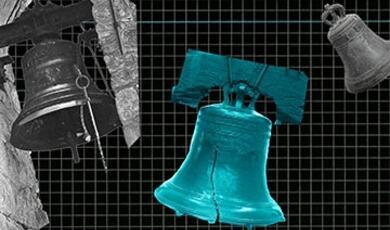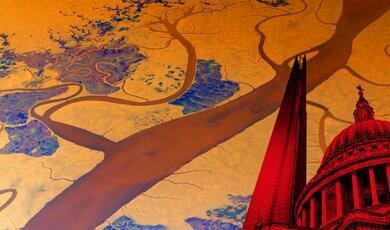Giant Waves on the Open Sea: Mariners’ tall tales or alarming fact?
Share
- Details
- Transcript
- Audio
- Downloads
- Extra Reading
Cinemagoers will be familiar with the thrill of giant waves. But what most people don't know is that the film The Poseidon Adventure is based on an incident involving the Queen Mary in WWII. The famous liner was hit by a giant 'wall of water' while she was carrying 15,000 American troops to Britain in 1942. The ship listed to an astonishing 52 degrees and almos capsized. More recently, The Perfect Storm will be familiar to most, providing an account of the sinking of the Andrea Gail south of Newfoundland in 1991.
Such giant waves are rare, and seldom recorded by reliable oceanograophic instruments. However, on 1 January 1995 a sensor on a platform in the central North Sea recorded a giant 60ft high wave crest, so 'freak' waves are not just tall tails. Giant waves can have disastrious consequences even for the largest ships and offshore structures.
Such waves are thought to be very rare but just how rare? What physics drives such waves? Is a 'wall of water' plausible? How hould engineers design structures to survive rare but potentially catastrophic events?
Download Transcript
GIANT WAVES ON THE OPEN SEA:
MARINER'S TALL TALES OR ALARMING FACT?
Paul H Taylor
Cinemagoers will be familiar with the thrill of giant waves. But what most people don't know is that the film 'The Poseidon Adventure' is based on an incident involving the Queen Mary in WWII. The famous liner was hit by a giant 'wall of water' while she was carrying 15,000 American troops to Britain in 1942. The ship listed to an astonishing 52 degrees and almost capsized. More recently, 'The Perfect Storm' will be familiar to most, providing an account of the sinking of the Andrea Gail south of Newfoundland in 1991.
Waves have been a source of fascination ever since mankind first gazed at the ocean. The sea has have been a favourite subject for many artists over the centuries. Turner painted many storm scenes including the Bell Rock Lighthouse, of considerable engineering interest and with a connection to Robert Louis Stevenson of Treasure Island fame. The woodcut print 'In the Hollow of a Wave off the Coast at Kanagawa' by the Japanese artist Hokusai is now famous as a remarkable image of fractals. Hokusai's vision of a giant breaking wave is now re-interpreted almost daily in popular culture.
The open ocean in winter is an unpleasant environment! A range of examples will be discussed, ranging from the unfortunate habit of the Cunard Queens to encounter giant waves and the loss of the German container ship München in 1978 to the risks taken by ocean racing yachts. Even Joshua Slocum, the first man to sail single handled around the world in the late 19th century, describes meeting a giant wave off the coast of Patagonia.
In fact there are remarkable similarities between the various accounts of seafarers' encounters with giant waves - walls of water, a hole in the ocean, a train of rollers.... What does modern research have to say about such descriptions?
Such giant waves are rare, and seldom recorded by reliable oceanographic instruments. However, on 1 January 1995 a sensor on a platform in the central North Sea recorded a giant 60ft high wave crest, so 'freak' waves are not just mariners' tall tales. Given the severity of the storm, our normal statistical models suggest that a series of storms of this severity would need to occur 100 times to have a 50% of seeing a single individual wave this tall in such a storm.
Such waves are thought to be very rare but just how rare? What physics drives such waves? Is a 'wall of water' plausible? Giant waves can have disastrous consequences even for the largest ships and offshore structures. How should engineers design structures to survive rare but potentially catastrophic events?
Computer simulations can now be made which incorporate much of the known physics of waves. These can give information on the dynamics occurring in giant waves and show that there is a tendency to form a long-crested event, which if steep enough, would match the descriptions of a 'wall of water'. Just as a wall is possible, so is a deep trench - the 'hole in the ocean'. Both appear in the simulations, it is simply a question of where the extreme event forms relative to the ship or offshore structure. It is remarkable that such an apparently simple set of mathematical equations can give rise to such results.
Such simulations are best visualised as computer-generated movies - which require as much computer time to make as the original simulation! Unfortunately academics don't have the computer power of the Hollywood studios so our movies are not quite as sophisticated. Whilst scientific results are customarily presented via graphs and equations, the advent of modern computer power requires new methods of visualisation - and the human eye is remarkably good at picking up features in moving images.
Whilst brute force computer simulations may produce interesting results, there is still the need for explanation and interpretation. The simplest model to reproduce the basic properties of the simulations is the nonlinear Schrödinger equation -a member of a class of nonlinear evolution equations investigated extensively by mathematicians over the last 40 years. Of historical as well as current interest is the first of these equations, the Korteweg-de Vries equation, derived in the late 19thcentury to describe waves on a canal. The explosion of mathematical results over the last 40 years is now being interpreted and applied to real-world waves in offshore engineering and oceanography. The nonlinear Schrödinger equation provides a starting point for an explanation for the dominant physics of the full simulations - the rapid contraction of wave groups along the direction of propagation and the rapid extension of the group along the wave crests. This leads directly to the 'wall of water'.
The talk concludes with a discussion of risk assessment in offshore engineering. From the application of sophisticated mathematics we return to the real ocean. It is important to appreciate that some degree of risk is inevitable in engineering practice. Large waves will occur and they may be larger than those a structure is designed for. Engineers shouldn't only produce a design that will just survive the 'design wave'. Instead, designs should be robust - able to survive with damage for waves greater than those anticipated.
©Paul H Taylor, Gresham College, 13 May 2008
This event was on Tue, 13 May 2008
Support Gresham
Gresham College has offered an outstanding education to the public free of charge for over 400 years. Today, Gresham plays an important role in fostering a love of learning and a greater understanding of ourselves and the world around us. Your donation will help to widen our reach and to broaden our audience, allowing more people to benefit from a high-quality education from some of the brightest minds.


 Login
Login







